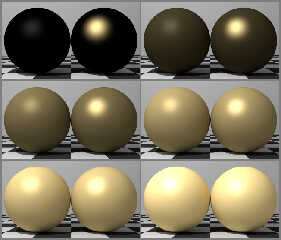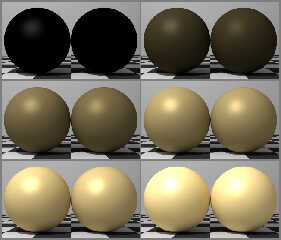|
 |
I can't remember exactly what I was doing Saturday--perhaps my memory
was wiped by the trauma of watch the New England Patriots get
routed--but I think I was pondering textures for my pending desk lamp
module when it occurred to me to revisit the relationship between
diffuse and specular in RC3Metal. I wrote a quick scene to test my
suspicion, and the news was not good.
The left sphere in each frame has a different pigment color per frame,
and diffuse 1 for all frames. The right sphere in each frame has the
same bright pigment in all frames, but a different diffuse value per
frame. It seems logical that if two spheres present the same color, the
macro setting the highlight should give both spheres the same highlight.
The good news is if you've been doing metals properly and using a high
value for the Specularity argument to my macros, this error will not
make a big difference. But if you've been using the highlight macro for
the purpose I intended--for cheating--your highlights are probably too
strong, and I need to fix that.
Post a reply to this message
Attachments:
Download 'test_diffuse_hilite-pbi.jpg' (60 KB)
Preview of image 'test_diffuse_hilite-pbi.jpg'

|
 |
|
 |
On 2022-01-17 19:52 (-4), Cousin Ricky wrote:
>
> It seems logical that if two spheres present the same color, the
> macro setting the highlight should give both spheres the same highlight.
>
> ... and I need to fix that.
Last night, while I was trying to get to sleep with a streetlight
shining through my window (long story), a solution came to me. There is
still a slight difference that I can't explain. My guess is that even
with a totally black pigment, there is some Fresnel effect, which
POV-Ray applies, while as far as my proposed solution is concerned,
diffuse 0 + reflection 0 = specular 0. I doubt the difference will be
significant in practice, but I may take a look at the Fresnel formula
anyway.
These are the textures used on the two black spheres:
----------[LEFT SPHERE (BLACK PIGMENT)]----------
pigment
{ color <0.0000, 0.0000, 0.0000, 0.0000, 0.0000>
quick_color <0.0000, 0.0000, 0.0000>
}
finish
{ reflection { 0.0000 metallic }
diffuse 1.0000
ambient rgb <0.0000, 0.0000, 0.0000>
emission 0
brilliance 1.6667
specular albedo 0.2500 metallic
roughness 0.02500
}
----------[RIGHT SPHERE (ZERO DIFFUSE)]----------
pigment
{ color <0.9900, 0.7600, 0.3300, 0.0000, 0.0000>
quick_color <0.9900, 0.7600, 0.3300>
}
finish
{ reflection { 0.0000 metallic }
diffuse 0.0000
ambient rgb <0.0000, 0.0000, 0.0000>
emission 0
brilliance 1.6667
specular albedo 0.000 metallic
roughness 0.02500
}
----------[END CODE]----------
P.S. About using zero reflection and a high diffuse in a metallic
texture, I did mention that I was cheating, right?
Post a reply to this message
Attachments:
Download 'test_diffuse_hilite-b1.jpg' (57 KB)
Preview of image 'test_diffuse_hilite-b1.jpg'

|
 |




![]()